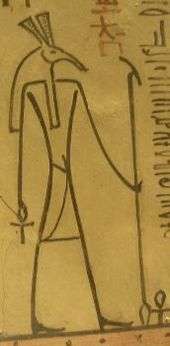Was-sceptre

The was ("power, dominion") sceptre is a symbol that appeared often in relics, art, and hieroglyphics associated with the ancient Egyptian religion. It appears as a stylized animal head at the top of a long, straight staff with a forked end.
Was sceptres were used as symbols of power or dominion, and were associated with the gods (such as Set or Anubis)[1] as well as with the pharaoh. Was sceptres also represent the Typhonic beast or Set-animal (the mascot of the Egyptian deity Set). In later use, it was a symbol of control over the force of chaos that Set represented.
In a funerary context the was sceptre was responsible for the well-being of the deceased, and was thus sometimes included in the tomb equipment or in the decoration of the tomb or coffin. The sceptre is also considered an amulet. The Egyptians perceived the sky as being supported on four pillars, which could have the shape of the was. This sceptre was also the symbol of the fourth Upper Egyptian nome, the nome of Thebes (called Waset in Egyptian).[2]
Was sceptres were depicted as being carried by gods, pharaohs, and priests. They commonly occur in paintings, drawings, and carvings of gods, and often parallel with emblems such as the ankh and the djed-pillar. Remnants of real was sceptres have been found. They are constructed of faience or wood, where the head and forked tail of the Set-animal are visible. The earliest examples date to the First Dynasty.
The was (wꜣs) is also the Egyptian hieroglyphic character that stands for a word meaning power.
| ||
| Was in hieroglyphs |
|---|
References
- ↑ "Horemheb KV 57". osirisnet.net. Retrieved 2012-07-23.
- ↑ "Was–sceptre". globalegyptianmuseum.org. Retrieved 2012-07-23.
External links
-
 Media related to Seth at Wikimedia Commons
Media related to Seth at Wikimedia Commons -
 Media related to Was sceptre at Wikimedia Commons
Media related to Was sceptre at Wikimedia Commons